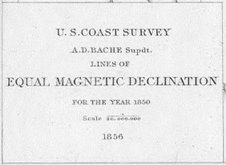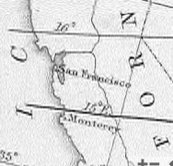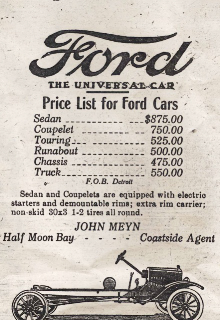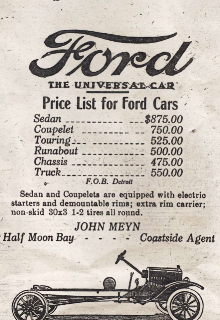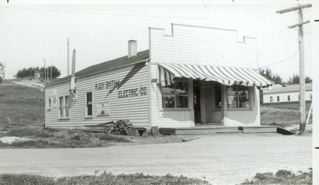Downey Harvey gives the Ocean Shore RR thumbs UP.
Story from John Vonderlin
Email John ([email protected])
This is from a five column advertisement in the April 19th, 1908 issue of “The Call.” This plea for citizen investment in their troubled company, tells a quite complete story of the company at this point in time. It also gives a slice of “Who’s Who” in the turn of the Century business circles of San Francisco. Perhaps, because I know how this turns out, I’m a bit cynical, but, explaining what bonds are in a newspaper ad, to the people you’re trying to sell them to, seems like a poor strategy, and reeks of desperateness. Enjoy. John
NOTE—-This announcement of the Ocean Shore is printed here for you to read. You can read this announcement with my positive assurance that every statement is bona flded and the officers of the Ocean Shore can and will substantiate them.
J. DOWNEY HARVEY
Pres. Ocean Shore Ry. Co.
Why is the Ocean Shore
selling bonds direct to the
people?
If the people own the bonds of the
Ocean Shore, they will be friends of the
road, and their confluence will be a big
factor in its favor. The rich and luxury
loving classes have been the bond buy-
ers of other roads; only a small percent-
age of the people have ever been given
a chance to buy bonds. Bonds are the
cream of all investments and are usual-
ly issued in denominations of $1,000
each, which enabled only the financiers
and bankers to buy such securities.
The usual plan for selling bonds was
to place the entire issue in the hands
of a group of bankers who were called
an underwriting syndicate. These men
agreed to take and pay for the entire
issuance of bonds at a price below their
par value. The syndicate then sold the
bonds to the public at an advanced rate,
keeping the difference for their profit.
The Ocean Shore bonds are sold by
the Ocean Shore Railway Co. direct to
the public and all the money received
from the sale of the bonds is used to
complete the railroad between San Fran-
cisco and Santa Cruz.
Why are Ocean Shore bonds
issued in denominations of
$100 instead of $1,000 each?
The general public as a rule cannot
afford to buy $1,000 bonds. Ocean
Shore bonds are issued in denom-
inations of $100 each to give every
person with at least $100 an op-
portunity to invest in these bonds and
get a class of security which has hereto-
fore been sold only to the rich. The
Ocean Shore prefers to have a great
many bond holders than a very few. .
The more bond holders the more
friends and patrons the road will have.
Why are Ocean Shore bonds
sold for $92 and $96— or below
their face value?
When times are hard and money scarce
it is necessary to make even sound in-
vestments attractive and profitable. The
Ocean Shore offers every bond buyer
a $100 bond for $92 cash. Interest rates
are high now, and when 5 per cent $100
bonds are sold at $92 the bond holder
receives 5.43 per cent interest on his
money. This higher rate of interest on
railway bonds is an inducement for in-
vestors to buy Ocean Shore bonds in
preference to other bonds.
The Ocean Shore needs money to
complete its railroad and must sell bonds
to get this money. Other railroads have
sold their bonds in favorable times when
31/2 and 4 per cent were considered high
interest rates.
Why are Ocean Shore bonds
the best investment for Caliifornians?
Ocean Shore bonds pay a higher rate
of interest— higher than most bonds
and they are an absolutely safe invest-
ment. The bonds are secured by a
$5,000,000 mortgage on the entire assets
of the railroad, which are valued at over
$9,000,000. This mortgage is held in
trust for the bond holders by the Mercan-
tile Trust Co. of San Francisco, who rep-
resents the bond holders.
The Ocean Shore is a California en-
terprise — it is the beginning of a great
railway system and the building up of
San Francisco by developing a very fer-
tile and naturally resourceful country
between San Francisco and Santa Cruz.
This railway will help to develop Cal-
ifornia, and in doing so, will add to the
material advancement of the state— and
increase business in all lines, giving em-
ployment to many men supporting fam-
ilies.
The Ocean Shore will increase property
values and everybody will be benefited,
and that is why Californians should in-
vest in Ocean Shore bonds.
Why is it necessary for the
Ocean Shore to sell bonds?
No railway is built without selling
bonds, The cost of railway building is
too expensive for any man or set of men
to finance without sellirig;bonds.
The owners of the Ocean Shore have
invested $3,000,000 of their own money;
and require more to complete the work,
they offer bonds to the public. When
a railroad requires more cash to buy
what they need it is not practical to se-
cure a loan from a bank or from an in-
dividual, so they issue bonds, which are
a part of a mortgage, and sell small parts
of a big mortgage to a great many people.
In other words, the bond buyer, loans
the road money, taking; as evidence of his
security a bond, and this bond is secured
by a first mortgage held by a trustee for
the bond holders.
Suppose the railway fails or is not
efficiently managed, what happens to
the bond holders?
If you are a stock holder in a railway
and it fails; you lose your money or a
part of it, because you are one of the.
owners; but as a bond holder you cannot
lose, because you can fall back on the first
mortgage, and the railroad with all its
property is yours. You, as a bond holder
are, “a preferred creditor” and the stock
holders are responsible to you.
Buying stock is risky, for it is a busi-
ness venture, but buying bonds is an in-
vestment which cannot be assessed or
taxed or made liable in any possible way.
Can the Ocean Shore earn
enough money to pay the in-
terest on its bonds?
Yes, and eight times more than enough.
The Ocean Shore has its depot at 11th
and 12th and . Mission and Market streets,
quite accessible to the local carlines and
homes of San Francisco. It has terminal
property in the hearts of the business
section of Santa Cruz, making this line
very convenient to passengers.
The railroad itself runs along, the
ocean for 70 miles, and is the grandest
scenic route in the world. The road
runs through very fertile land upon
which there is produced 1,200 carloads
of cabbage and 400 carloads of arti-
chokes every year. There are a great
many vegetable gardens, orchards, dairies,
lumber mills,bitumin quarries, lime
and paving rock quarries, besides 1 ,500,-
000,000 feet of the finest redwood timber
in the world. .
There are seven tanneries on the line
of the Ocean Shore, and these tanneries
will use enormous quantities of tan bark,
which can be hauled from the forests on
the Ocean Shore direct to these tan-
neries.
There are also many deposits of ce-
ment and building sand along the line.
Freight arrangements have already
been made with two concerns which will
net the Ocean Shore $200,000 a year.
Railway experts figure the possible
earnings of the Ocean Shore at over
$2,000,000 a year, while the bond interest
only amounts to $250,000 a year.
What do the assets of the
Ocean Shore consist of?
These assets, valued at $9,000,000, con-
sist of valuable terminal facilities in San
Francisco and Santa Cruz with a real
estate value of over $2,000,000; rights
of way, track privileges, railroad tracks,
lands, equipment and privileges. The
terminal facilities in San Francisco have
a value far in excess of the total
amount of bonds issued. This property is
rapidly increasing in value and will soon be
regarded as inestimable, for it is very likely
that a large union depot will be built at 11th
and 12th and Mission and Market streets,
and all the railroads entering San Francisco
will meet at this common center, giving San
Francisco the largest union depot in the state.
What are the present earn-
ings of the Ocean Shore?
During the month of March, the Ocean
Shore earned over $7,000 from its train
service between San Francisco and San
Pedro, and over $l,500 from its line be-
tween Santa Cruz and Scott Creek. The
latter showing is very low because lumber
mills at Scott Creek were closed and
usual shipments deferred.
The earnings of the Ocean Shore will
be greatly increased as soon as the road
reaches Half Moon Bay, and more cars
can be secured. At the present time the
equipment is inadequate and hundreds
of people are turned back every Sunday
because there are not cars enough to
accornmodate all who desire to patronize
the lirie. New cars have been ordered; and
when they are put into use the company
can accommodate freight and patrons and
earn several thousand dollars a month more.
When will the Ocean Shore
be entirely completed?
The Ocean Shore is more than half
completed. The track is laid and in op-
eration between San Francisco and Far-
allone City, 24 miles, and also between
Santa Cruz and Scott Creek, 16 miles.
Over 85, per cent of the .grading is fin-
ished between Farallone City and Scott
Creek.
Over 400 men have been at work
since January 15th. Three steam shovels
are also working night and day. The
work is going ahead as rapidly as possible
with a limited supply of money. At the
present rate of bond sales the road will
reach Half Moon Bay by July 1 and
Santa Cruz by January 1. When through
to Santa Cruz and money is available
the Ocean Shore will be electrified and
double tracked.
How much money is re-
quired to entirely complete
the road?
$2,500,000 more will complete this
road in accordance with the plans. The
company, will run high power electric cars
from San Francisco to Santa Cruz in
21/2 hours. Such a service will attract
many thousands of passengers, who will
patronize this line on account of the ex-
cellency of the service offered and be-
cause of the attractive features and re-
sorts along the route.
How many bonds have been
sold? Who are buying Ocean
Shore bonds?
The total issue of bonds amounts to
$5,000,000, of which $2,250,000 has been
sold and the money spent on the road
and equipment.
There are $2,750,000 bonds to be sold.
Ocean Shore bonds have been purchased
by several hundred of the enterprising,
progressive citizens of California. Many
of the large bond holders are men of
prominence in business and banking cir-
cles. Many of these bond holders are
large property owners of San Francisco
and Santa Cruz. Many are banks and
some are held by. estates and insurance
companies. Hundreds are held by men
and women of moderate means.
The following is a small list of bond
holders, any one of whon you may ask
about Ocean Shore bonds.
Rev. Fr. Crowley. Youths’ Directory, Harry Stetson,
Director of Metropolitan Trust and Savings Bank,
Reuben H. Lloyd. Henry Epstein, Walter S. Martin,
Pres., Oregon Land Co., John I. Sabin Estate, Late
Pres. Pac. Tel. Co., J. R. Stetson, Pres., Calif.
Street Railway Co., L. Bocarequez, Pres. French-
Amercan Bank, Herman Shainwald, Pres. Shainwald
and Buckbee Co., Peter D. Martin, Vice Pres., Eastern
Oregon Land Co., S. G. & S. C. Buckbee. Shainwald,
Buckbee & Co., Wm. Berg, Wm. Berg & Co., Grain,
C. C. Moore, Pres., C. C. Moore & Co., engineers,
Thomas Magee, Pres., Thos. Magee & Sons., Peter F.
Dunne, Gen’l Atty., So. Pac. Co., J. J. Mack. Pres.,
Imperial Oil Co., A. Mackie, Supt. S. F. Relief and Red
Cross Funds, J. A. Folger, Pres., J. A. Folger Co., L.
Guggenhime, Pres., Thirty-three Oil Co., E.S. Pillsbury,
Pillsbury, Madison & Sutro; Director Mercantile Trust Co.,
A. W. Haas, Haas Bros., Wholesale Grocers., H. D.
Pillsbury, Pillsbury, Madison & Sutro, Atty, A, T, & Santa
Fe, Richard Oxnard, Pres., Western Sugar Refinery, C. E.
Lilly, Director, People’s Bank of Santa Cruz, Alexander
Hamilton, Vice Pres., Baker & Hamilton, W.E. Dean, Pres.,
California Insurance Co., Thos. McClay, Wickersham Bank,
Petaluma, B. Schweitzer, Hoffman, Rothchild & Co.,
People’s Bank of Santa Cruz, Fireman’s Fund Ins. Co,
and Bank of Santa Cruz County.
How can I satisfy myself
that your statements are true?
The books of .the Ocean Shore Rail- :
way Co. are open to every reasonable
man who wishes to examine them. The
Ocean Shore has nothing to conceal from
any one. The stock holders have paid
real money for their stock and the head
officers are serving without salary.
All of the officers and employes are
willing, to give you detailed information
about the railway. There is every possi-
ble opportunity for you to satisfy your-
self .that the Ocean Shore is honorable,
upright and an honest organization
which has invested every dollar received
from the stock holders and the bond hold-
ers economically and honestly.
Who are the directors and
officers of the Ocean Shore?
J. Downey Harvey, the president, is
connected with many of the larger finan-
cial interests of the coast and is a direc-
tor in two of the largest banking houses
of the c\ty of San Francisco, viz : the
First National Bank and First Federal
Trust Company.
Mr. J. A. Folger. First Vice President,,
is the president of J. A. Folger & Co.,
one of the largest and oldest mercantile
enterprises on the Pacific coast. Mr.
Folger is known as a conservative and
shrewd business man, and his long and
successful career should recommend him
to all for conservatism and good judg-
ment.
Mr/ Horace D. Pillsbury of the legal
firm of Pillsbury, Madison & Sutro is
Second Vice President. Mr. Pillsbury is
one of the prominent attorneys of the
state and a leading member of the bar
of Sa/i Francisco. He is the attorney
for the Atchison, Topeka and Santa Fe
railroad and is prominent in other large
enterprises.
Mr. Peter D. Martin, Director. Mr.
Martin is a member of one of the oldest
and best known pioneer families of Cali-
fornia. He is connected with many large
interests in California and Oregon and
is vice president of the Eastern, Oregon
Land Co. He has large property inter-
ests in San ‘Francisco.
Director Charles C. Moore is president
of C. C. Moore & Co., engineers, one of
the largest engineering concerns in the
west. Mr. Moore is probably one of the
best known men on the Pacific coast, as
he is at the head of the. pioneer designing,
constructing and engineering concern of
the» Pacific coast, with branches at New
York, Seattle, Salt Lake’ City and Los
Angeles.
Mr. Burke Corbet is general counsel
and secretary. Mr. Corbet is one of the
prominent members of the bar of the
city of San Francisco and is well known
to most residents of this city and state.
What assurance have I that
my money is safe and my in-
terest secure?
Your money, when invested in Ocean
Shore bonds, will be expended on the
railway — it will help to increase the
value of the road and give added secur-
ity to the bond holders, of which you will
be one. You will be associated with
prominent men of San Francisco who
have a reputation for their business hon-
esty and integrity.
You will be a bond holder in a great
railway system which will have a splen-
did future and be of great value to San
Francisco and California. Your money
will be secured by the $5,000,000 mort-
gage on our $9,000,000 of assets.
Your interests in the railway will be
as carefully watched as the interests ot
the officers and directors. And in. addi-
tion to securing a high rate of interest on
your investment, you will be helping an
enterprise which will in turn be a help
to you.
On what terms are Ocean
Shore bonds sold?
$100 Ocean Shore bonds are sold for
$92 cash, or $96 on easy payments— $l6
down and $10 a month for eight months.
At the end of eight months you get $2.50
interest on your installment payments,
which practically reduces the cost of
your bond to $93.50.
When the road is completed these
bonds you buy for $92 and $96 will sell
in the open market for $110 and $120 and
in the meantime pay you 5.43 per cent
and 5.21 per cent on your investment.
Can I go over the road and
see for myself what you have?
You certainly can. If you are inter-
ested and every true loyal Californian
should be, please call at the office of the
president, who will tell you everything
you want to know, and when he has
given you complete information he will
give you a pass, which will entitle you
to all. the courtesies of the train crew,
and you can go over this most magnifi-
cent scenic/route and see exactly what
the Ocean Shore has done and how well
the work has been done.
You will be treated courteously, po-
litely and be entertained as any good man
or woman should be — and when you are
through with your examination you are
free to invest or not, as you choose, with-
out being under any obligation what-
ever, to buy Ocean Shore bonds.
Booklets sent on request.
———————————–
From Angelo Mithos
Thanks, John, for the attachments. Yes, a good example of the desperate straits the OS was in. Listed in a 5/14/09 S.F. Call “Legal Notices” column are the names of stock holders who’d forfeited their shares for failure to pay the $5 levy per share the OS had assessed. Among them is H.D. Pillsbury, which name appears among the
references for prospective Ocean Shore bond buyers in your attachment. It was really sad in a way. Ironically. under an adjoining column, same page (P. 13), under “Investments,” individuals and firms are offering OS bonds for sale at reduced prices, described by one as “…an absolute safe, splendid investment, free from risk”–and yields described variously as from 4 to 8%. A lot of trusting small people besides the big guys got stung by the OS. Angelo

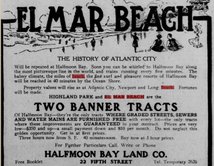
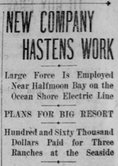
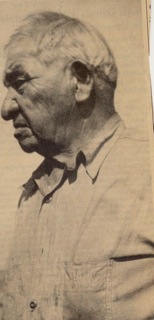 Andres Osorio: Did the last Costanoan live and die in Half Moon Bay?
Andres Osorio: Did the last Costanoan live and die in Half Moon Bay?